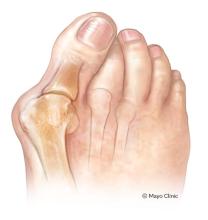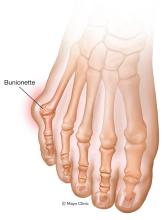Bunions
Conditions
Overview


A bunion is a bony bump that forms on the joint at the base of the big toe. It happens when some of the bones in the front part of the foot move out of their regular position. This causes the big toe to get pulled toward the smaller toes. It also forces the joint at the base of your big toe to stick out. The skin over the bunion might change in color and feel sore.
Wearing tight, narrow shoes might cause bunions or make them worse. Bunions also can form due to the shape of the foot, a foot defect or a condition such as arthritis.
Smaller bunions, called bunionettes, can form on the joint of the little toe.
Symptoms
The symptoms of a bunion include:
- A bulging bump on the outside of the base of the big toe.
- Swelling, a change in color or soreness around the big toe joint.
- Corns or calluses — these often form where the first and second toes rub against each other.
- Ongoing pain or pain that comes and goes.
- Stiffness or limited movement of the big toe, which could lead to trouble walking.
- Hard skin on the sole of the foot.
When to see a doctor
Bunions often don't need medical treatment. But some symptoms should be checked by a member of your health care team. Or you could see a doctor who treats foot conditions, called a podiatrist, or an orthopedic foot specialist. Get a checkup if you have:
- Ongoing pain in the big toe or foot.
- A bump on the big toe joint.
- Less movement in the big toe or foot.
- Trouble finding shoes that fit properly because of a bunion.
Causes
Many theories exist about how bunions form. But the exact cause isn't clear. Factors likely include:
- Inherited foot type.
- Foot stress or injuries.
- Defects present at birth.
Experts disagree on the role that shoes play. Some say that tight, high-heeled or narrow shoes cause bunions. Others say that footwear simply contributes to bunions forming.
Bunions might be linked with some types of arthritis. The link is especially strong with types of arthritis that involve painful swelling due to a problem with the immune system. These conditions include rheumatoid arthritis.
Risk factors
These factors might raise the risk of bunions:
- High heels. Wearing high heels forces the toes into the front of the shoes. Often, this crowds the toes.
- Shoes that fit poorly. People who wear shoes that are too tight, too narrow or too pointed are more likely to get bunions.
- Rheumatoid arthritis. Having this condition can make you more likely to get bunions.
- Genes. The tendency to get bunions might be due to an inherited problem with the structure or anatomy of the foot.
Complications
Bunions can lead to health problems that include:
- Bursitis. With this condition, the small fluid-filled pads that cushion the bones near the joints become inflamed. This leads to pain.
- Hammertoe. This is an irregular bend that happens in the middle joint of a toe. Usually, it affects the toe next to the big toe. It can cause pain and pressure.
- Metatarsalgia. This condition causes pain and swelling in the ball of the foot.
Prevention
To help prevent bunions, choose shoes carefully. They should be supportive and have a wide toe box — no pointy toes. There also should be space between the tip of your longest toe and the end of the shoe.
Your shoes should match the shape of your feet without squeezing or pressing any part of your foot.
Diagnosis
To find out if you have a bunion, your health care professional asks you about your symptoms and checks your foot. After the physical exam, an X-ray of your foot can help determine the best way to treat it.
Treatment
Treatment choices for a bunion vary. They depend on how severe your bunion is and how much pain it causes.
Simple changes and medicines
Often, surgery is not needed to relieve the pain and pressure of a bunion. Your health care team may recommend options such as:
- Different shoes. Wear roomy, comfortable shoes that give your toes plenty of space.
- Padding. Bunion pads or cushions that aren't medicated may help ease your pain. They can act as a buffer between your foot and your shoe. You can buy the bunion pads or cushions without a doctor's prescription.
- Medicines. Acetaminophen (Tylenol, others), ibuprofen (Advil, Motrin IB, others) or naproxen sodium (Aleve) can help you control the pain of a bunion. Cortisone shots also might help.
- Shoe inserts. Padded shoe inserts can help spread out pressure evenly when you move your feet. This eases your symptoms and may slow your bunion from progressing. Supports sold at the store without a prescription can relieve some people's symptoms. Other people need prescription shoe inserts called orthotic devices.
- Use of ice or an ice pack. You can ice your bunion after you've been on your feet a long time or if the bunion becomes inflamed. The coldness can help relieve soreness and swelling. Don't place ice directly on your skin. Wrap it in a towel first. Then use it for 15 to 20 minutes at a time. If you have reduced feeling or blood flow problems with your feet, check with your health care team before you use ice.
Surgery
You might need surgery if simpler treatments don't ease your symptoms. Surgery is recommended only when a bunion causes you frequent pain or limits your daily activities. Usually, it's not done to improve how your foot looks.
There are many surgeries for bunions. No one technique is best for every problem.
Surgeries for bunions can be done as single procedures or in combination. They might involve:
- Removing the swollen tissue from around the big toe joint.
- Straightening the big toe by removing part of the bone.
- Realigning one or more bones in the forefoot to correct the irregular angle in the big toe joint.
- Joining the bones of the affected joint for good.
Depending on the surgery done, you might be able to walk on your foot right after a bunion procedure. But a full recovery often takes up to six months.
To keep another bunion from forming, you'll need to wear proper shoes. Most people shouldn't expect to wear narrower shoes after surgery.
Talk to a member of your health care team about what you can expect after bunion surgery.
Preparing for your appointment
You'll likely start by seeing your primary care doctor. Or you might see a foot doctor called a podiatrist or an orthopedic foot specialist.
What you can do
Prepare a list of questions before your appointment. This helps you make the most of your time with your health care team. Your questions might include:
- What's causing my foot problems?
- Is this condition likely to last a short time or a long time?
- What treatment do you recommend?
- Is surgery right for me? Why or why not?
- Are there other self-care steps that might help?
- What are the potential benefits, risks and complications of bunion surgery?
Feel free to ask any other questions during your visit.
What to expect from your doctor
Some questions your health care professional might ask include:
- When did your foot problems start?
- How much pain do you have in your foot?
- Where is the pain?
- What, if anything, seems to improve your symptoms?
- What, if anything, appears to make your symptoms worse?
- What type of shoes do you wear?
- If surgery is considered, what are your expectations?
© 1998-2025 Mayo Foundation for Medical Education and Research(MFMER). All rights reserved. Terms of Use
